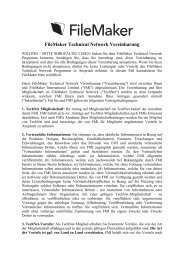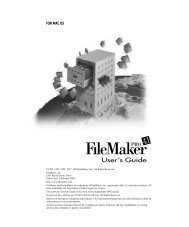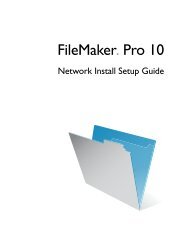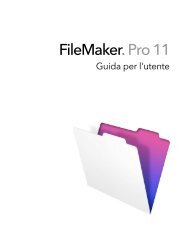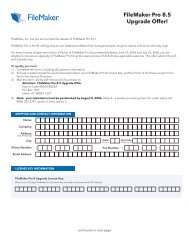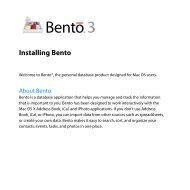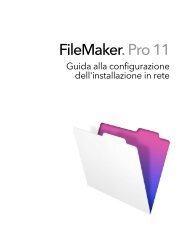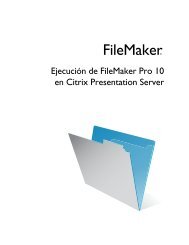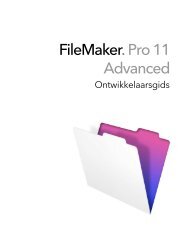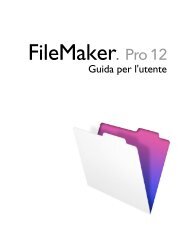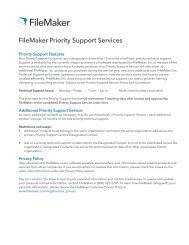Guida di FileMaker Server 12
Guida di FileMaker Server 12
Guida di FileMaker Server 12
You also want an ePaper? Increase the reach of your titles
YUMPU automatically turns print PDFs into web optimized ePapers that Google loves.
Utilizzo <strong>di</strong> ODBC e JDBC con <strong>FileMaker</strong> <strong>Server</strong> Con<strong>di</strong>visione <strong>di</strong> database <strong>FileMaker</strong> tramite ODBC e JDBC<br />
Con<strong>di</strong>visione <strong>di</strong> database <strong>FileMaker</strong> tramite ODBC<br />
eJDBC<br />
Nota Le seguenti informazioni sono destinate ad amministratori server.<br />
Importante La con<strong>di</strong>visione ODBC e JDBC è <strong>di</strong>sponibile solo se si possiede una licenza <strong>di</strong><br />
<strong>FileMaker</strong> <strong>Server</strong> Advanced.<br />
È possibile usare <strong>FileMaker</strong> <strong>Server</strong> Advanced per ospitare un file <strong>di</strong> database <strong>FileMaker</strong> come<br />
origine dati, con<strong>di</strong>videndo i dati con altre applicazioni usando ODBC e JDBC. <strong>FileMaker</strong> <strong>Server</strong><br />
consente fino a 50 connessioni e supporta l’accesso locale (stesso computer) e remoto (sia per<br />
middleware, come i server Web, sia per l’accesso remoto dei client da applicazioni produttive desktop).<br />
Per ospitare un database <strong>FileMaker</strong> Pro ospitato tramite ODBC e JDBC:<br />
1. In <strong>FileMaker</strong> Pro, aprire il database e mo<strong>di</strong>ficare il set <strong>di</strong> privilegi per gli account che<br />
accederanno al database. Consentire il privilegio esteso Accesso tramite ODBC/JDBC.<br />
Per ulteriori informazioni, vedere la <strong>Guida</strong> <strong>di</strong> <strong>FileMaker</strong> Pro.<br />
Nota Se la soluzione <strong>di</strong> database <strong>FileMaker</strong> utilizza più <strong>di</strong> un file <strong>di</strong> database <strong>FileMaker</strong>, tutti i<br />
file <strong>di</strong> database devono utilizzare questo set <strong>di</strong> privilegi con il privilegio esteso Accesso tramite<br />
ODBC/JDBC attivato.<br />
2. Nell’Admin Console <strong>di</strong> <strong>FileMaker</strong> <strong>Server</strong>, fare clic su ODBC/JDBC e selezionare Attiva<br />
ODBC/JDBC.<br />
3. Caricare il file <strong>di</strong> database su <strong>FileMaker</strong> <strong>Server</strong>. Vedere la sezione Hosting <strong>di</strong> database.<br />
Nota Se la soluzione <strong>di</strong> database <strong>FileMaker</strong> utilizza più <strong>di</strong> un file <strong>di</strong> database <strong>FileMaker</strong>, tutti i<br />
file <strong>di</strong> database devono essere ospitati sulla stessa <strong>di</strong>stribuzione <strong>FileMaker</strong> <strong>Server</strong>.<br />
4. Su ogni computer client che deve accedere al database ospitato, installare e configurare il<br />
driver client ODBC o JDBC <strong>FileMaker</strong>.<br />
Per dettagli su come installare e configurare un driver client per accedere all’origine dati<br />
<strong>FileMaker</strong>, consultare la GUIDA ODBC E JDBC FILEMAKER sulla Pagina iniziale.<br />
Argomenti correlati<br />
Utilizzo <strong>di</strong> ODBC e JDBC con <strong>FileMaker</strong> <strong>Server</strong><br />
GUIDA DI FILEMAKER SERVER <strong>12</strong> 100



